| << . 1 . 2 . 3 . 4 . 5 . 6 . 7 . 8 . 9 . 10 ... 12 . 13 . >> |
| Author |
Message |
Brettny
Member
|
# Posted: 5 Aug 2020 11:36am
Reply
Unless your getting very cheap batteries hooking up that many solar pannels dials going to Be very costly. Short loads like you would use in a shop I would look into the cost difference to running a generator. Sure "free" power is nice but remember you only have one piece of a huge solar array, the pannels. Charge controllers, large DC breakers, batteries all cost. Then you add in that your site dosnt get that much sun..
|
|
ICC
Member
|
# Posted: 5 Aug 2020 02:09pm
Reply
Quoting: paulz How much battery? Good point.
That is your starting point.
|
|
paulz
Member
|
# Posted: 6 Aug 2020 10:06am
Reply
OK, I will concentrate on battery. Not sure how to figure it though. For example, in the shop that I am building, downhill from the cabin, I have right now 2 group 24 deep cycle batteries in parallel hooked to 250 watts of solar and an inverter. Yesterday I ran saws, a sander and a planer off an on. Battery voltage ran down to 12.0 at times, and when the sun hit the panels it rose to 13 at times, but at the end of day it was down to 12.2 unloaded. If I take a day off they will get back up to 12.5, but if I don't it will continue a cumulus drain.
If I envision a larger system to run a compressor, lathe or what not, it seems like it would be the same scenario, how much time I can work vs. how much recovery time.
I guess that's how solar works..
|
|
paulz
Member
|
# Posted: 6 Aug 2020 10:10am
Reply
Quoting: Brettny Unless your getting very cheap batteries hooking up that many solar pannels dials going to Be very costly. Short loads like you would use in a shop I would look into the cost difference to running a generator. Sure "free" power is nice but remember you only have one piece of a huge solar array, the pannels. Charge controllers, large DC breakers, batteries all cost. Then you add in that your site dosnt get that much sun..
Sorry Brett, just saw your post. Funny sometimes posts seem to pop up that weren't there last I checked.
Yes I've been thinking about good old generator power. I ran my old trusty 110v generator yesterday to run a belt sander for a good bit of time and didn't want to run my batteries down too much. While it was running I also plugged in a battery charger.
So yes, generator power, at least for 'shady' me, is still an important part of the power puzzle.
|
|
paulz
Member
|
# Posted: 6 Aug 2020 10:16am
Reply
Before I came across all these panels, I had bought 12 panels (first post on this thread), and later an Epever charge controller. I put that on back burner when this other stuff came along but I think I should probably back up and get that going, connected to the 4 matching group 24 deep cycle lead batteries I have just sitting, and see what that gets me.
And continue my solar learning experience.
|
|
garrybrown
Member
|
# Posted: 24 Aug 2020 08:04am
Reply
I actually just bought two of the 100 watt solar panels the other day for my van build. Getting them in Tuesday.
|
|
paulz
Member
|
# Posted: 16 Sep 2020 07:21pm
Reply
I'd like to hook up a few of my hoard of solar panels, in series, to the EP Tracer SCC with the remote meter and 4 deep cycle batteries in parallel, just so I get some experience. Nothing to power at present, I could hook up an inverter and have a disco dance party I guess.
The SCC says 150v pv input, which would be several panels, but only 520 watts at 12v, or two of the 260 watt panels. Is that right?
The black MP4 wires are fine for the pv hookup I assume. I also got a bunch of green wire, 6AWG, not sure where that was being used. Would that suffice for SCC to batteries? How about battery to battery? Or do I need 0-1 AWG?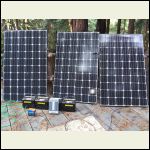
20200916_155621_resi.jpg
| 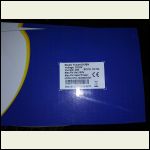
20200916_155825_2.jp.jpg
| 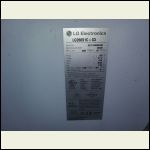
20200916_155705_resi.jpg
|  |
|
|
ICC
Member
|
# Posted: 16 Sep 2020 08:51pm
Reply
Green is the same as bare; used ONLY for ground wires.
Quoting: paulz The SCC says 150v pv input, which would be several panels, but only 520 watts at 12v, or two of the 260 watt panels. Is that right?
Yes there are watt input limits as well as max voltage input limits, max current OUTPUT too, so if those numbers are what the manual for the CC states, that is correct. The max watts for the CC is always lowest for 12 volt batteries and increases for 24, 48..... doubles for 24, doubles again for 48. And remember that the listed max voltage is the sum of the Voc panel voltage multiplied by 1.25 (to cover you for cold weather voltage increase); Or is from what a string calculator, if available for that CC, computes for input weather data along with the panel specs and quantity.
|
|
|
ICC
Member
|
# Posted: 16 Sep 2020 08:53pm
Reply
Also, FYI, if you connect more than two in parallel you should have a fuse or breaker for each parallel panel or series string of panels.
|
|
paulz
Member
|
# Posted: 16 Sep 2020 09:56pm - Edited by: paulz
Reply
The SCC Manual confuses me, please have a look:
https://www.epsolarpv.com/upload/cert/file/2003/Tracer-BN-SMS-EL-V1.2.pdf
The box, in the image in my post above, shows the 520 watt max pv input, but page 10 shows max pv array power 1560W. It also shows rate charge power 520W, maybe the box label is wrong? Mine is the bottom one 40 amp.
Thanks ICC.
|
|
ICC
Member
|
# Posted: 16 Sep 2020 10:37pm
Reply
Here's what I make of it. The unit is rated for a max charge current of 40 amps. Divide the rated 520 watts by 12 volts and you get 43.33333 That is close enough. To the rated 40.
You can wire up more watts worth of panels, up to 1560 watts total, but the CC will not exceed a charge rate of 40 amps. Any extra available incoming watts will be "burned off" by the CC. That creates heat and that can be the downside of overpaneling by too great of an amount. Running hot for extended periods can shorten electronic components life. Actually it will shorten life, not just "can". That is the main reason computer data centers are run quite cool; air conditioned down to where most people wear sweaters.
The advantage of overpaneling a little is that when the sun is less than optimum the CV can make up some of what is missing from the extra panel capacity.
|
|
paulz
Member
|
# Posted: 16 Sep 2020 11:06pm - Edited by: paulz
Reply
That makes sense. So 1560 divided by my 260W panels is 6 panels. The panels are rated at 8.35 IMPP, 6 would be 50 amps. Panel VOC is 38.5V, 6 would be 231V, way over the 138V spec.
Sounds like maybe 4-5 panels max.
EDIT: Hmm, 2 strings of 3 panels.. 1560W, 50A and only 115V
|
|
Nobadays
Member
|
# Posted: 17 Sep 2020 11:05am
Reply
We are using 6x245w and 3x 250w panels with nearly identical amps/volts. VOC=37.5, ISC= 8.68, so really close to your output. We run 3s/3p for 2,220 watts total.
From what I have read it is quite common to stick with 3s unless you are linking small panels... of the same output.
That is theoretically 112.5v max, and 26.04 amps. We are using a Schneider 60/150 charge controller and it handles the input easily. We could probably add another string but wire size from the combiner to the SCC would have to be increased to do that. We have plenty of power.
|
|
paulz
Member
|
# Posted: 17 Sep 2020 05:22pm
Reply
Sound good Nobs. I'm going to try 3s/2p but I need to get MC4 branch connectors to do parallel. Surprised in all the cabling I got there were none.
Thanks!
|
|
Nobadays
Member
|
# Posted: 17 Sep 2020 06:46pm
Reply
If you are going to work with solar, a good MC4 crimper is a must. This ONE is a pretty cheap set and comes with connectors and the tools to tighten and uncoupled the connectors. A wye connector like THIS will let you do 3s2p pretty neatly.
Have fun!
|
|
justinbowser
Member
|
# Posted: 17 Sep 2020 10:05pm
Reply
If I were you I would also wire your bank as 24V unless you have already invested in a 12V inverter.
|
|
paulz
Member
|
# Posted: 17 Sep 2020 10:35pm - Edited by: paulz
Reply
Got the wye connectors coming. Justin, unfortunately I have a couple of 12 volt inverters I use.
Don't suppose I could put the two inverters in series. Or, I see they make 40 amp 24 to 12v step down converters for $30. I guess with that I could double the pv wattage.
|
|
paulz
Member
|
# Posted: 18 Sep 2020 10:15am - Edited by: paulz
Reply
I did some searching, believe it or not others have asked about series connecting 12v inverters. The general answer no but no explanation why. I'm intrigued, not that I really need to, just what would happen.
Anyway with my SCC limited to 40 amp pv input, going to 24v and upping the wattage would raise the amps above the 40 amp limit I'm already hitting at 12v. Right? Amps are cumulative, parallel or series?
|
|
justinbowser
Member
|
# Posted: 18 Sep 2020 10:40am
Reply
Doubling your battery bank voltage cuts the amp input requirement to an inverter roughly in half for the same watt output. It all boils down to the equation P=I x E. A side benefit of upping the voltage is that since the current decreases your wire size can also safely decrease which saves you a little money. As far as stringing together inverters in series I doubt it would work.
|
|
paulz
Member
|
# Posted: 18 Sep 2020 11:17am
Reply
Thanks Justin. I'm not getting it, look at the specs below. At the bottom it says 'Max PV input current 40A'. In the chart above that it says 'Max PV array power 1560W/12V or 3120W/24V'.
But if you divide 1560 or 3120 by 12 or 24 you get 130A, way over the 40 mentioned.
What am I doing wrong?
|
|
ICC
Member
|
# Posted: 18 Sep 2020 03:49pm
Reply
The amp rating on MPPT charge controllers is the output or charging amps, not the max amps from the PV. That table is wrong.
The main input limit is voltage. One must take the Voc of the PV panels plus 25% cold allowance to determine the theoretical maximum from the PV. The big names also have online pv string sizing tools specific to their brand of equipment. These also let you enter temperature data as what happens in Phoenix is different from what happens in Buffalo, NY.
The other input limit is total PV wattage, which varies with the nominal voltage of the battery bank the output is connected to.
When the connected total PV wattage exceeds the rating, the CC should be designed to safely "burn off" the excess as waste heat. There will be a max allowable amount varying between makes. This same thing of making wadte heat happens when an MPPT CC switches from bulk to absorb if the sun is still shining brightly. Electronic components don't like heat so longer life may be expected when limits are not exceeded.
|
|
ICC
Member
|
# Posted: 18 Sep 2020 05:11pm
Reply
The inverters with series DC input question is more difficult.
I suspect that if inverter A and B had their 12 volt DC inputs connected to a 24 volt DC battery the components in each inverter would sense the 24 volts and because they were not designed for 24 volt input power would either (a) burn out some coponents from the voltage being too high or (b) shut down immediately if they had over-voltage protection. My 12 volt Samlex has 16 volt overprotection. Samlex tells me it will shut down if that is exceeded, but I've not tested that.
A friend had an inverter that he was having intermittent troubles with. It would shut down and not start up for several hours. It took a while but we figured out that when the batteries were equalized the battery voltage would be about a half volt too high and the inverter sensed that and shut down. When the CC stopped equalizing it would work again. Better inverters are made to be able to work while the battery is being equalized, but I doubt there are any 12 volt inverters that would work on 24 volts.
The other problem would arise if the outputs of inverter A and B were to be combined. The waveform of the two inverters are bound to be in different phase. That would cause one or both inverter to burn out. This is related to why you can couple two Honda inverter generators using a special connector cord. The sync cord allows the electronics to blend the two waveforms into one.
Similarly there are some inverters whose outputs can be joined in a manner to supply 240 volts AC from two separate, matched 120 volt AC output inverters. (Outback as an example).
|
|
paulz
Member
|
# Posted: 18 Sep 2020 05:22pm
Reply
Thanks ICC. So as Justin said above, I can jam double the watts, 3120 into the SCC at 24v than the 1560 at 12v, and both are under the 138v at 25c in the spec.
So how does that affect the charging of my 4 lead batteries, in 12 or 24 config? Faster charging?
Yeah I won't be trying the series DC inverter combo test, I need those things. What about a 24-12 step down converter?
|
|
ICC
Member
|
# Posted: 18 Sep 2020 06:09pm
Reply
Quoting: paulz I can jam double the watts, 3120 into the SCC at 24v than the 1560 at 12v, and both are under the 138v at 25c in the spec. So how does that affect the charging of my 4 lead batteries, in 12 or 24 config? Faster charging?
When the input is maximized on either the 12 volts or the 24 volts batteries, the output charge current is still at up to 40 amps, for either 12 or 24 volts. So, IF you have the same number of batteries in both cases, just have them configured differently, and IF 40 amps are being output, THEN the batteries will be charged faster.
12 volts (nominal) at 40 amps = 480 watts and 24 volts at 40 amps = 960 watts. At 24 volts double the watts would be put into the same batteries at 24 volt configuration instead of 12 volts configuration.
But remember when there is LOTS of sun hitting those panels there is LOTS of waste power that the CC must disperse as heat . Yes the mfg states it is okay to have up to 1560 watts with a 12 volt battery or 3120 watts with a 24 volt battery. IF you did have full sun hitting the panels in a 12 volt configuration then the CC would have to disperse 1560 watts - 480 watts = 1080 watts of power. That is a lot of heat. The CC better be mounted in a well ventilated space; a space you do not want to needlessly heat.
|
|
ICC
Member
|
# Posted: 18 Sep 2020 06:22pm
Reply
Quoting: paulz What about a 24-12 step down converter?
The following is my opinion.
I think those can be useful for running a few small 12 VDC devices when one has a higher volt battery bank. I use a 48 to 12 VDC converter and a 48 to 24 converter for a few small special things. Some are meant to be for emergency use only when or if I might have an equipment failure due to lightning, for example.
However, it seems to me that if the object is to operate something at 120 VAC then inserting a converter like that is just another level of inefficiency to be added to the loses in the inverter. You can't get away from inverter loses, though some units are more efficient than others. It is more like a band-aid than a solution to me because I don't like power waste.
You have some good panels that should serve you well for years. Maybe enough to salt a couple away in storage in case of an accident? Enlarging a system using the previously used different voltage equipment can end up with a cobbled together system with more parts, more potential points of failure and less efficiency.
|
|
paulz
Member
|
# Posted: 18 Sep 2020 07:12pm
Reply
OK I get the wattage increase at 24v, thanks. Is the reason for the input rating being so much higher so that under less than full sunlight you may still get 40 amps (and at full sunlight the rest is burned off by the SCC)?
It sounds like even at 12v I will have plenty of charging for the batteries I have, and I can start looking for a higher voltage inverter.
|
|
ICC
Member
|
# Posted: 18 Sep 2020 09:26pm
Reply
Quoting: paulz Is the reason for the input rating being so much higher so that under less than full sunlight you may still get 40 amps (and at full sunlight the rest is burned off by the SCC)
Yes, having more available input watts than what can actually be used gives a performance cushion. At the expense of higher component temps.
|
|
justinbowser
Member
|
# Posted: 18 Sep 2020 10:53pm - Edited by: justinbowser
Reply
Remember also that your DC wiring can be smaller gauge since when you go from 12V to 24 you still supply the same wattage to the load but at half the amps... I have a 24 - 12 converter that I run my 'fridge on, LED bulbs are 24V and pretty much everything else is AC.
|
|
paulz
Member
|
# Posted: 19 Sep 2020 09:58am
Reply
The pv-scc wiring I got with the panels looks like the same black MC4 connector wire that comes out of the panels. Silver (aluminum?) conductor, about 3/16", probably 6awg or so. I'm thinking 25-50' of that to get to the SCC, one + and one -. The batteries will be within 10' of the SCC, I have 6awg copper for that, or I could double it up, or cut up some car jumper cables.
This may sound even cheaper/dumber than my usual MO, but why not use copper plumbers tape I have to connect battery to battery? Already got holes, adjustable...
My 5kw inverter already has heavy cables. I've been using it with 2 12v deep cycles hooked to the Harbor Freight solar kit, but they've been having a hard time keeping up lately with reduced sun, so this setup may come in handy.
|
|
paulz
Member
|
# Posted: 21 Sep 2020 06:36pm - Edited by: paulz
Reply
A move is afoot! Today I hauled 6 panels to my shop roof and set them against the edge of the back wall. I need to build some racks to get them out on the roof where there is a bit more sunlight. But this is about as good as it gets, and for only a couple hours.
I hooked 3 panels in series, and in full shade they still showed 90 volts. Does that mean they are still putting out something?
Does it make any difference if panels are horizontal instead of vertical?
The SCC will be inside the shop, other side of the wall from where the panels are sitting. Would it be OK to have the batteries (lead acid) inside as well? It's a large, well ventilated shop. Otherwise I will have to run battery wire back outside through the wall, and then back inside for inverter and DC.
The other pic is from the front of the shop. The sun is somewhere in the gap in the trees. Once it passes that gap it's game over.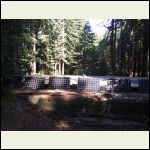
20200921_131027_resi.jpg
| 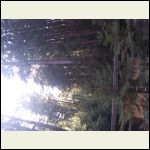
20200921_131027_resi.jpg
|  |  |
|
|
| << . 1 . 2 . 3 . 4 . 5 . 6 . 7 . 8 . 9 . 10 ... 12 . 13 . >> |

